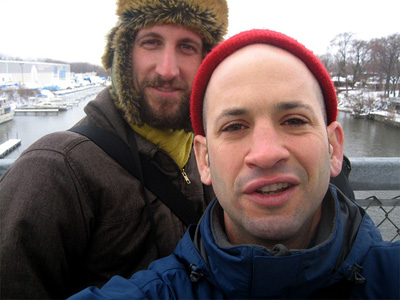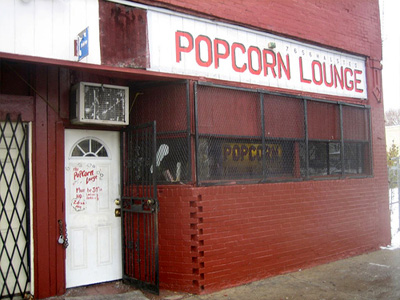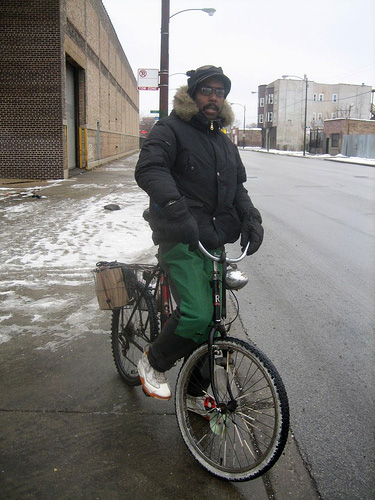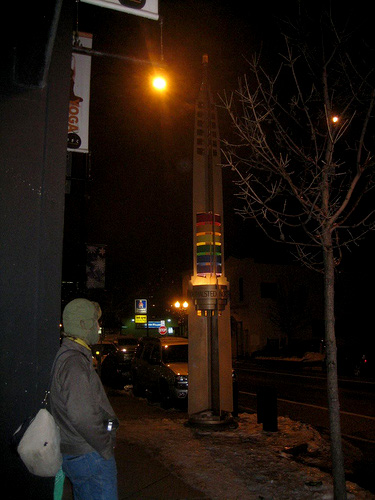800 West - Gapers Block: Detour (original) (raw)
I don't walk much in Chicago; most of the time I ride a bicycle or take transit. But I have taken some epic hikes in the city. Back in '95 I strolled Milwaukee Avenue from the West Loop to the suburb of Niles, about 11 miles. A few years later I followed Western Avenue from Blue Island to Evanston, about 24 miles, over the course of two days. Walking an entire street is a great way to get a feel for the vastness of our town and to experience its architectural, economic and cultural diversity.
When Time Out Chicago recently did a special on Western Avenue, one of the world's longest streets, it reminded me how satisfying it was to complete those urban hikes. I decided it was time to take on Halsted Street, one of our most famous and varied thoroughfares. It runs through Chicago from 129th Place in gritty West Pullman, a working-class, black neighborhood, to Grace St., 3800 North, in gentrified Boystown, the center of gay life in the city. Halsted is shorter than Western, but with less car lanes and slower traffic it's also a more walkable street and perhaps a more interesting one. If I could complete the 20-mile stretch in a day it would be the longest walk of my life.
According to Streetwise Chicago by Don Hayner and Tom McNamee, Halsted was originally named First Street, then Dyer Street in honor of Charles Volney Dyer, an abolitionist who aided hundreds of freedom seekers on the Underground Railroad. Later it was renamed after William and Caleb Halsted, brothers and bankers from Philadelphia who helped Chicago Mayor William Ogden finance his real estate ventures. Early on, Halsted was referred to as the Egyptian Road because it eventually made its way to southern Illinois, known as "Little Egypt." Today Illinois Route 1 follows the street from I-57 at 99th Street far into the south suburbs. The highway ends at the Kentucky border by Cave-in-Rock State Park, which used to be a hideout for Ohio River pirates.
This fall I persuaded my buddy Kevin Monahan to join me on this excursion, but we kept procrastinating until Sunday, Dec. 9, long after the temperature had dropped below freezing and several inches of snow had fallen. An ice storm hit the night before and the sidewalks of our neighborhood, Humboldt Park, were glazed and treacherous as we made our way to the CTA Blue Line. An hour and a half later Pace Bus 352 dropped us off at 130th and Halsted in the village of Riverdale, between Whistler Forest Preserve and the Joe Louis "The Champ" Golf Course. We were just south of the Little Calumet River, Chicago's southern border. There were no sidewalks here and wooded areas on either side. At 10am, after ducking behind trees to pee, we began our march.

On the way to the bridge over the river we passed the Riverdale Marina where a couple of yachts hibernated at the dock. At the apex of the bridge I found a bootleg CD of Atlanta rapper Gucci Mane's album "Trap-A-Thon" lying in the snow and we shot a self-portrait with the water behind us. As we crossed into the city the scenery suddenly changed from rural to urban. Halsted became a four-lane street with parking, left-turn bays and sidewalks lined with storefront churches, day-care centers, barbershops and Harold's Chicken shacks — we counted three within a seven-mile stretch. Virtually everyone we'd encounter for the next 90 blocks was African-American.
Here the concrete was covered with a grainy slush that was easier to walk on than the glare ice we encountered up north and Kevin, half a foot taller than me, set a brisk pace. We passed the Cedar Park Cemetery, the Halsted Bowl bowling alley and the Jetsonian Kleen Towne Cleaners building. At 119th we crossed the Major Taylor Trail bike path, named after the black man who dominated bicycle racing at the turn of the 20th Century.
We stopped for brunch at the Roseland neighborhood's S & E Diner, 11117 South, where signs told us the building was for sale. It was a cozy, old-fashioned café with booths and a long lunch counter, decorated for the holidays with tinsel and poinsettias. The wall behind the counter was crowded with framed photos of regulars, memorabilia from the Civil Rights Movement and a Sears Tower-shaped plaque honoring the late Mayor Harold Washington.
At 11am we were the only customers — there wasn't even a pot of coffee on the burner. Perhaps the place fills up after church services let out. The young woman behind the counter seemed a bit wary of two Caucasian strangers, as if she suspected we were undercover cops. "This is a really cool place," I said, trying to make conversation. "It's a shame it's not going to be around much longer." "Yes, it is," she said dryly.
I got devil-red salmon croquettes, eggs, grits and biscuits; Kevin carbo-loaded with French toast, home fries and a pancake. The food was delicious but the high butter and grease content troubled Monahan, a vegan. When it was time to pay, an older lady who had cooked the meal came out to ring us up. She was as friendly as the waitress was taciturn. She asked us if we had gotten our Christmas shopping out of the way and was delighted when Kevin said he was giving plants and homemade nut butters as gifts. "What a wonderful idea!"
North of there, the development became car-oriented, dominated by fast-food chains, strip malls and big-box stores with huge parking lots. At 101st we stopped to gaze at a banner outside the headquarters for the Warriors Drum & Bugle Corps "for boys and girls age 10 to 20." A young man, dressed in a baseball cap and turtleneck with a rhinestone-studded crucifix medallion, came out to greet us and tell us about the program. "We have church services too — you're welcome to come back and join us any time you like. We don't see color here, just souls."
A block later we came upon a mural titled "Our Brothers and Sisters from Day One" painted on the side of the Halsted Auto Diagnostic Clinic. It features dozens of figures from African and African-American history, from Queen Nefertiti to Frederick Douglass to Louis Farrakhan, the latter portrait added in recent years by a graffiti artist. After we crossed I-57 at 99th, Halsted became dominated by bungalows and three-flats, followed by a bleak stretch of industrial land and vacant lots. As we passed under the Metra tracks at 87th, a woman who was missing a few teeth slogged through the snow shouting into her cell phone. "I'm walking! Come get me then!"
The sidewalks had grown slippery again and Kevin and I had several near-spills, catching our balance only by windmilling our arms. "I wonder who's gonna fall first," he said. In the Auburn-Gresham area we started seeing local businesses once more. On 79th Christmas wreaths hung on the lampposts below the star-and-crescent sign for a mosque. Around 1:30pm we decided to rest our feet at the Popcorn Lounge, 7656 outh., where we could hear loud R & B playing on the sound system. Printing on the door warned "Must be 30. No Loitering / Peddling. 2 drink min."

"Can I help you?" said the woman who was tending bar, pointing at the door - I had left it wide open. I mumbled an apology and we walked past a row of 50s-ish men in leather jackets and sat down. She studied our IDs carefully, perhaps guessing we'd been sent by the Liquor Control Board. "What do you have on draught?" Kevin asked. "Miller." I asked for one and she handed me a bottle of Miller Genuine Draft. Monahan ordered a Hennessy. As my friend and I chatted amongst ourselves I think the bartender realized we were harmless. She walked over to the jukebox and put on a soul singer's cover of "Tush" by Z.Z. Top, probably for our benefit.
Refreshed, we continued north to 71st where a brown street sign for "Honorary Emmett Till Drive" commemorates the young Civil Rights martyr. At 65th bike lanes were visible for the first time on our walk, installed as part of the redevelopment of the former Englewood Shopping Plaza site. Kennedy-King College is relocating to the area and several big new buildings were visible by the Green Line stop at 63rd. As a result, property values are rising in what has long been one of the city's poorest neighborhoods. We were shocked to see Spartan new three-flats nearby with signs advertising condos "from the $200s."
At Garfield Boulevard, 5500 South, we saw another mural, titled "Women Against Oppression," painted on the side of LeMeck's, a steak house with a huge, old-fashioned neon sign. Soon afterwards a guy rode past us on a mountain bike with wire baskets on the back and a large silver headlamp, one of the few cyclists we'd spotted all day. "If we see him again I'm going to flag him down and talk to him," I declared.
A mile down the road we saw him pedaling towards us and I held up an index finger to catch his attention. Frank White III, who lived nearby at 56th and Union, was more than happy to talk. He asked Kevin, an IT specialist, for advice on getting around the password for a computer he had salvaged. He mentioned he was trying to break into the bike messenger business, so I suggested a few companies he could try. But he was really interested in telling us about his Rottweiler, Ren. His dog had been gotten attacked by one of the local pit bulls and nearly got his ear torn off. After that, Frank trained him to fight by waving a rag in the air for his dog to attack; since then Ren hasn't had any trouble with the neighborhood bullies.

As we continued through the Canaryville neighborhood, formerly home to the Union Stock Yards, an unpleasant dog food-like odor emanated from G & W Packing, the last remaining meat processor in the area. Kevin's vegan nostrils were particularly offended, but the smell must have been nothing compared to the stench of the stockyard in its heyday as described in Upton Sinclair's The Jungle. We stopped by the old Stock Yards Gate at Exchange St., 4200 South, a massive limestone arch crowned by a steer's head. Nearby, a recently-installed monument to fallen Chicago firefighters resembles a miniature version of the Vietnam War Memorial, topped by doughy sculptures of firemen with anguished faces.
A few blocks later we entered Bridgeport, the historically blue-collar, Irish- and Italian-American neighborhood where both mayors Daley grew up. Here the demographics changed abruptly and for the rest of our walk we saw mostly white faces. A cold mist was blowing in from the north so we ducked in for a beer at Schaller's Pump, 3714 South, an old tavern that has long been a hangout for local politicians. The 11th Ward headquarters is right across the street. There are few windows on the front of the bar and you have to enter from the parking lot through the side of the building, apparently so patrons can come and go discreetly. As we entered the bar, the waitress stared at my salt-stained shoes; it seemed like outsiders aren't particularly welcome there. The décor probably used to be pretty interesting, but the place had been redecorated recently and there wasn't much to look at besides some old photos of the White Sox and a grinning Richard J. Daley.
When we left Schaller's at 4:30pm it was already dark outside. Bridgeport feels like a small town in the city and as we continued through the 30s we passed a number of unique small businesses: the Ramova Grill, 3510 South; Augustine's Spiritual Goods, 3327 South; Let's Boogie Records, 3321 South; the Healthy Food Lithuanian Restaurant, 3236 South; and Ed's Potsticker House, 3139 South. We picked up some apples at the Egg Store produce market, 3008 South, before heading next door to the Unique Thrift Store where Kevin bought some bandanas and a knit cap. As we were leaving he realized he'd dropped a glove and had to go back inside. On the way out the security guard gave him the third degree and searched his bag for several minutes as I watched through the glass door. Monahan was cursing when he returned. "The guard said, 'Maybe you're not shoplifting but how do I know you weren't hired by my boss to test me?'"
In a few blocks we crossed the south branch of the Chicago River into the east side of the Pilsen neighborhood, a once Czechoslovakian, now largely Mexican-American area that has seen an influx of other new residents in recent years, including many artists. We passed by the Skylark bar, 2149 South, a popular hangout for local Bohemians (painters, not Czechs). Many of the storefronts on this stretch of Halsted house galleries and much of the land is owned by the Podmajersky family, the Medicis of Pilsen.
After passing through a long railroad viaduct at 16th we found ourselves in the newly created University Village district, the University of Illinois at Chicago's prefab college town. Formerly the Maxwell Street area, it was home to a stretch of funky men's wear stores, a huge Sunday flea market and two 24-hour Polish sausage stands, Jim's Original and the Original Maxwell Street. Peddlers used to stand outside hawking tube socks and porno tapes at all hours of the night in the grilled onion-perfumed air. Most of the old buildings were razed and replaced by generic-looking university offices, condos, chain stores and fast-food franchises.
Crossing the Eisenhower Expressway by the UIC-Halsted Blue Line station at 500 South, we got a fine view of the Sears Tower and other Loop skyscrapers topped by red and green lights that shined through the murky night. "Do all the building managements get together and agree to light their buildings the same color," I mused, "Orange for Halloween and pink for Breast Cancer Awareness Month?"

Just north of the Ike, Greektown was quiet on this dismal Sunday evening, but neon signs for its shops and restaurants buzzed cheerfully in the mist. As we crossed Madison Street, Chicago's north-south bifurcating street, I cried, "Now we're back on the North Side!" and the street addresses began increasing again. We passed by Club Paradox, 159 North, a strip club where some cat from Japan I used to know once worked as a male dancer.
Our feet were getting weary once more so we stopped for a third drink at the TNT Lounge, 184 North, a bar I'd read about in the great guidebook Chicago's Best Dive Bars by Jonathan Stockton. It's a predominantly African-American hangout around the corner from the fancy Randolph Market dining district. Kevin was impressed by the green pressed-tin ceiling and I noted a sign behind the bar for "Brain Day," a chess and checkers session on Mondays at 6:30. A nook near the front window was lined with records, and as a "stepper's cut" played on the sound system an older gentleman grabbed the hand of a young woman with dreads and they danced with gusto.
Moving on, we trudged through slush on a bridge over railroad tracks and the Kennedy Expressway, catching a whiff of chocolate from the nearby Blommer factory. Descending to the six-way intersection with Grand and Milwaukee I spied the huge mural for the Funky Buddha Lounge which portrays the spiritual leader as a chubby man in a feathered bowler enjoying a snifter of brandy. A few blocks later at Chicago Avenue the Prairie concrete plant loomed to our left with its huge silos and dozens of cement mixers.
We crossed the north branch of the Chicago River onto Goose Island, the city's only isle, and stopped at the curiously named Flaming Wok, 901 North, an Indian and Pakastani restaurant that caters to cab drivers. When I asked to see a menu, the man behind the counter spooned small portions of various curries onto a plate for us to sample. "I'm going to have to veto this," whispered Kevin. "I'll tell you why later." Feigning an upset stomach, Kevin apologized to the counterman and we left. Outside he told me he had once taken a food safety course and he noticed that the curries were sitting lukewarm in trays and were microwaved just prior to being served — ideal conditions for food poisoning.
Crossing back off the island at Division Street, 1200 North, we saw the last remaining high rises of the Cabrini Green housing project, destined for the wrecking ball to make room for new condos. A couple of the windows of the bleak concrete towers had black smudge marks smearing upwards, probably from kitchen fires. Approaching the Red Line station at North Avenue, 1600 North, I finally slipped on the icy sidewalk and fell palms first on the pavement, losing our gentleman's bet.
From here on, Halsted Street became a pleasant, two-lane thoroughfare lined with bike lanes and parked cars, dense with boutiques and eateries, theaters and taverns. It occurred to me that this is the terrain that comes to mind when most North Siders think of Halsted, but in reality this well-scrubbed territory makes up only the northern tenth of the 20 mile street.
Kevin remembered that a friend of his was working at Café Ba-Ba-Reeba, 2024 North, a stylish Tapas bar, so we stopped in for free drinks and plates of marinated vegetables and grilled baby squid. We continued pub crawling a few more blocks to a new Irish pub called Trinity, 2721 North, in the Lincoln Park neighborhood near DePaul University. Monahan had read on the internet that drinks were half price there on Sundays; this was not the case, but pints of Guinness were a reasonable $3. The Colts were playing the Ravens on TV and a couple of frat brothers high-fived after a touchdown. "Yes, we are in Lincoln Park," I sniffed.

At Belmont Street, 3200 North, we spotted the phallic, rainbow-ringed monuments that mark the entrance to Boystown, with its multitude of gay bars and dance clubs. We'd invited a gay friend to join us on this odyssey but he wound up canceling due to inadequate footwear. So, while it might have been more fitting to have our last drinks at a gay venue like Roscoe's, Sidetracks or the Cell Block, we demurred and went to the strip's only straight bar, the Town Hall Pub, 3340 North.
The place was almost deserted, but it was a pleasant dive with Christmas lights and old photos plastered over the back bar. I'd heard it was a Deadhead hangout, but mellow indie rock was playing on the jukebox as Julie the punky, tattooed barmaid held court. We were nearly done with our walk so we toasted our accomplishment with pints of beer, followed by complimentary shots of Julie's homemade jalapeno-infused vodka backed by beakers of Bloody Mary mix.
We left the day's sixth bar and staggered the remaining four blocks to the finish line, the terminus of Halsted at Broadway and Grace, 3800 North, where I tagged the northernmost Halsted Street sign. It was 10pm, 12 hours after we'd begun our expedition.
I ducked into the adjacent 24-hour IHOP to urinate before we caught the CTA home. A sign of the door insisted that restrooms were for customers only, so I asked the host for a blueberry muffin to go. Confused, he replied that they didn't have muffins. "Would you like some pancakes?" The manager came over to facilitate. When they turned their heads for a moment I made a bee-line for the bathroom. The manager followed me. "Are you getting an order for here or to go?" he demanded. "Uh, to go," I said, opening the door.
On the way back I considered making a break for the exit, but instead I opted to tipsily address the host again. "Um, what kind of scones do you have?" The poor bastard, probably tired of dealing with late night drunks, replied tartly. "We don't have scones. You could try Caribou Coffee or Starbucks." In the interest of not being a complete jerk, I bought a small cocoa and left.
Kevin was waiting outside with a sheepish expression on his face. The manager had busted him at the restaurant's dumpster in mid-pee. We retreated south and I stood guard as he finished the job behind an abandoned muffler shop next to the local police station. Relieved, we walked west two more blocks west on Addison Street towards Wrigley Field and the Red Line, en route to our warm beds.